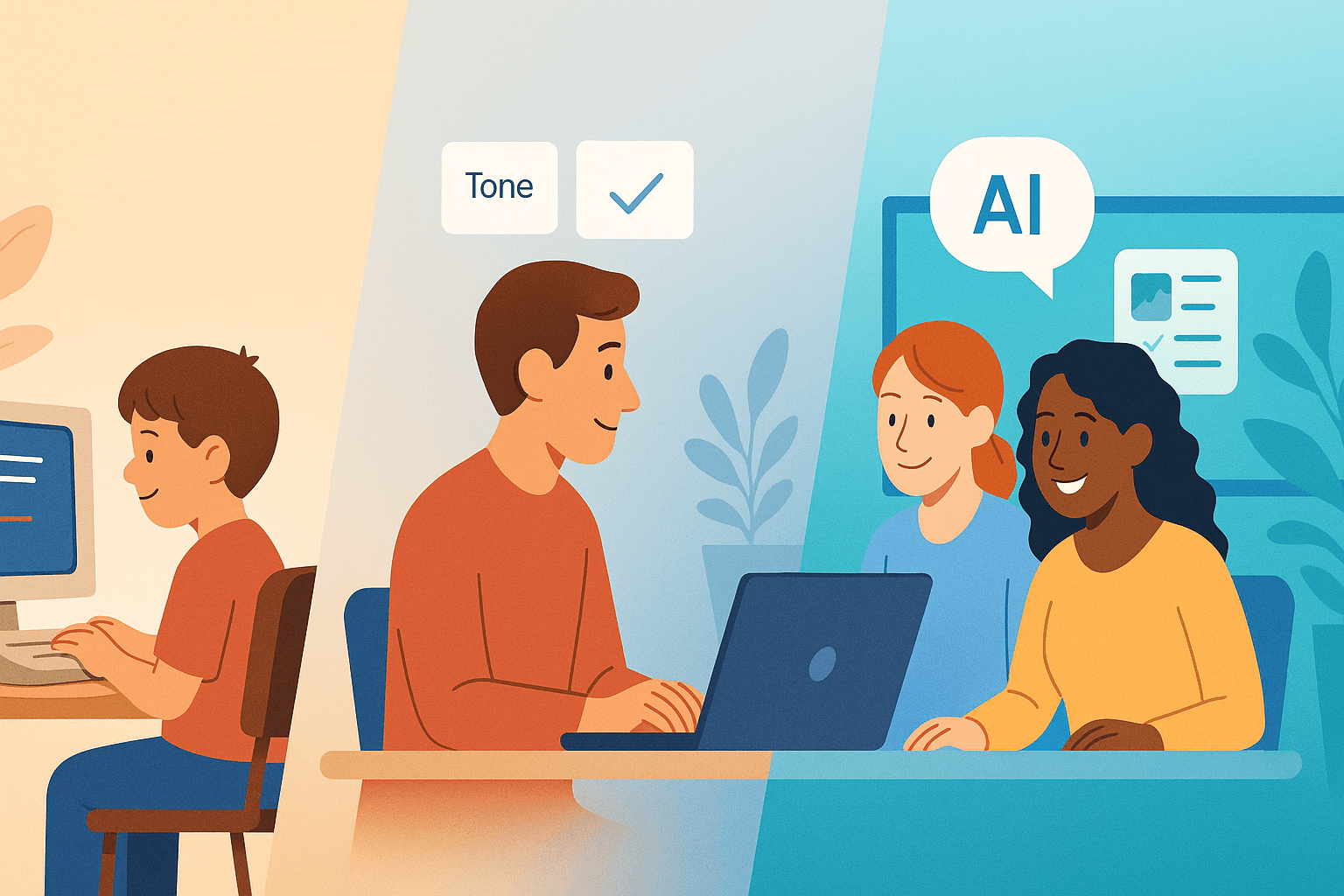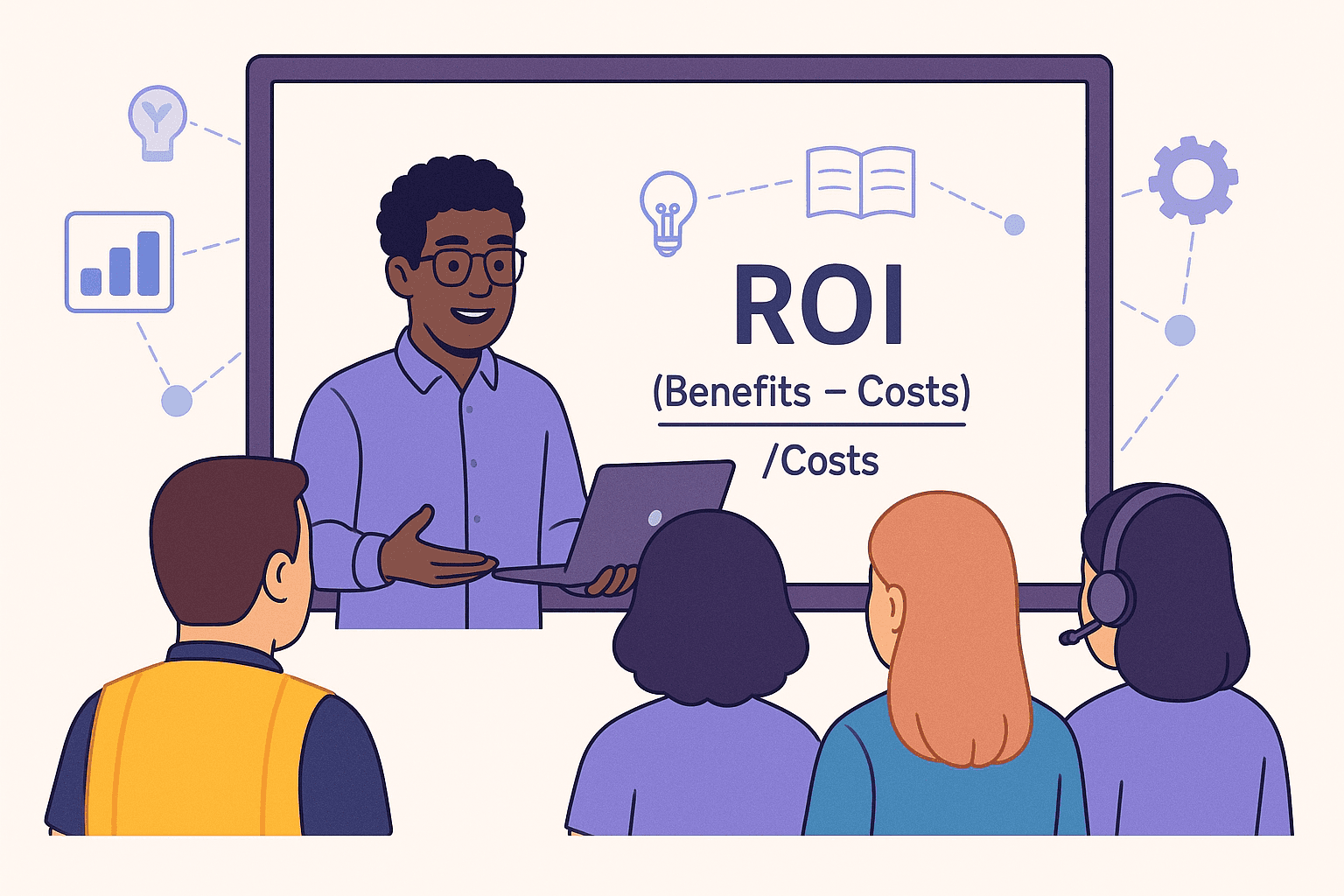7 min
Oct 23, 2024
People are transforming their textbooks into interactive modules...how?
Lara Cobing

When I was in my freshman year, I would often get bored and sleepy while studying my thick, black-and-white psychology textbook. The dense, monotonous text and lack of engaging visuals made it difficult to stay focused. To keep myself alert and interested, I resorted to highlighting and drawing in the margins. This simple act helped me stay engaged with the material, but I couldn't help but wonder—what if there were a better way to learn? A way that didn’t rely on doodles and highlighters to maintain my attention?
Fast forward to today, and the answer is clear: interactive textbooks. These digital resources combine text with multimedia elements, quizzes, and interactive features, creating a dynamic learning experience that keeps learners engaged. No longer do students or trainees have to wade through pages of text—interactive textbooks make learning an immersive, hands-on process, transforming the way we absorb information.
In this article, we’ll explore how interactive textbooks enhance learning, the essential features to look for, and the best authoring tools available
Why Interactive Textbooks Matter for HR Professionals and Educators
Interactive textbooks offer a comprehensive solution for presenting structured, in-depth content. For HR professionals managing corporate training programs, these textbooks can transform dull onboarding manuals into interactive learning guides. Employees can not only read the material but engage with it through videos, quizzes, and scenario-based learning. Similarly, in academic settings, interactive textbooks help educators create an environment where learners actively participate in the material rather than passively consuming it.
Harvard University has integrated interactive textbooks and multimedia content into their online courses, particularly through platforms such as HarvardX and the initiatives led by the Harvard Initiative for Learning and Teaching (HILT). These courses use real-time feedback, interactive videos, and multimedia support to help students absorb complex materials. For example, the Advanced Quantitative Methods course at the Harvard Kennedy School uses interactive modules, quizzes, and diagrams to allow students to learn at their own pace, reserving class time for deeper discussions and advanced topics.
General Electric (GE) has also implemented interactive content in its employee training programs through initiatives such as the Brilliant Learning curriculum. This program, launched in 2017, focuses on providing hands-on, interactive training to over 150,000 global supply chain employees. It incorporates a blend of workshops, online courses, and immersive boot camps that cover critical areas like lean manufacturing, advanced digital technologies, and additive manufacturing. These components are designed to foster employee engagement and enhance skill development in real-time work environments, such as manufacturing sites.
GE’s investment in interactive content aligns with its broader strategy to bridge the skills gap in the manufacturing industry. By leveraging technologies such as simulations and real-time tasks, GE helps employees not only learn but apply new skills directly within their roles. This model of interactive, hands-on learning ensures that employees are prepared to meet the demands of the digital industrial economy.
Key Features of Interactive Textbooks
Unlike traditional textbooks, interactive textbooks are packed with features designed to boost engagement and retention. Here’s what makes them stand out:
Multimedia Integration: Incorporating various forms of media such as videos, images, audio clips, and interactive charts can cater to different learning styles and make complex information more digestible.
Annotations and Collaborative Features: Allowing learners to add notes, highlight text, and engage in discussions directly within the textbook fosters a collaborative learning environment. This feature is particularly beneficial in corporate training, where peer learning and feedback are crucial.
Real-Time Updates: Interactive textbooks can be easily updated to reflect the latest information, ensuring that the content remains relevant and accurate. This is especially important for industries that undergo frequent changes, such as technology and compliance training.
User-Friendly Navigation: With long-form content, intuitive navigation is key. Features like bookmarks, searchable text, and easily accessible menus help learners navigate through chapters and sections seamlessly.
Authoring Tools for Creating Interactive Textbooks
Several tools are available that make creating interactive textbooks easy and efficient. Here are some of the top tools available, with a focus on their ability to handle long-form content and interactive features.
Mindsmith
Mindsmith is an intuitive, cloud-based authoring tool designed to simplify the creation of eLearning content, including interactive textbooks. Mindsmith focuses on ease of use, making it an excellent choice for both beginners and experienced instructional designers.
Features:some text
AI generated content – Mindsmith allows you to upload your content to turn into an interactive module. If you need the content verbatim in the module, just say so! And Mindsmith will turn your boring textbook into a rich, engaging eLearning.
Drag-and-Drop Interface – The intuitive drag-and-drop editor allows users to easily create interactive textbooks without needing advanced technical skills. You can embed multimedia, quizzes, and interactive elements into the textbook with just a few clicks, making the content more engaging and accessible.
Multimedia Integration - You can incorporate videos, images, and audio files into your interactive textbooks. This is particularly useful for educators who want to explain complex concepts through visual aids and demonstrations
Real-Time Collaboration- One of Mindsmith's unique features is its support for real-time collaboration. Multiple users can work on the same textbook simultaneously, making it ideal for teams creating content together. This feature is perfect for institutions or corporations where multiple subject-matter experts contribute to the development of training materials.
Adobe Captivate
Known for its versatility, Captivate allows for the creation of responsive interactive textbooks that work on multiple devices. It integrates seamlessly with Learning Management Systems (LMS) and supports complex multimedia elements.
Features:
Advanced multimedia integration - You can embed videos, audio clips, images, and animations seamlessly within the textbook chapters, turning passive reading into an interactive, multimedia experience. This is essential for subjects that require visual demonstrations, like biology, engineering, or art history.
Interactive elements like quizzes and simulations - Adobe Captivate enables the inclusion of quizzes, drag-and-drop activities, clickable hotspots, and pop-up windows that allow learners to engage directly with the content. For example, you can create embedded questions within the textbook chapters to test comprehension as students read.
Responsive design for mobile and desktop - Textbooks created with Adobe Captivate are responsive, meaning they automatically adapt to different screen sizes. This is especially useful for students accessing textbooks on their mobile devices. Captivate offers a responsive layout that maintains a consistent and optimized user experience across desktops, tablets, and smartphones.
Kotobee
A specialized platform for building interactive eBooks and textbooks. It offers features like annotations, embedded quizzes, and multimedia that make it perfect for educational content.
Features:
Interactive widgets (e.g., quizzes, interactive images) - Kotobee provides a library of over 15 interactive widgets, such as quizzes, interactive images, video embedding, and audio narrations. These elements can be integrated seamlessly into the textbook content to create an engaging learning experience. For example, interactive images can allow students to zoom in on diagrams, while quizzes embedded within the textbook can test comprehension in real time.
Multi-Platform Support - One of Kotobee’s standout features is its ability to publish interactive textbooks across multiple platforms. This includes mobile apps, web platforms, Windows, and macOS, ensuring that the textbooks are accessible across all devices. This cross-platform capability is essential for educational institutions or corporate trainers who need to reach learners wherever they are.
Offline Access and Custom Apps In addition to online capabilities, Kotobee enables offline access, allowing students to download the textbook to their devices and access it without an internet connection. You can also create a custom-branded app for your interactive textbook, providing a tailored experience for your institution or organization.
How to Choose the Right Tool for Your Interactive Textbooks
Selecting the appropriate authoring tool depends on several factors, including your specific needs, budget, technical expertise, and the intended distribution platform.
Content Type: If you’re creating corporate onboarding guides, look for tools that offer features like quizzes, multimedia support, and SCORM compliance. For academic textbooks, consider tools that provide collaboration features and detailed analytics.
Collaboration Needs: Tools like Mindsmith and Kotobee offer real-time collaboration, which is especially useful for peer reviews or instructor feedback.
Budget and Skill Level: Some tools, like Adobe Captivate, may require more technical expertise but offer advanced features. Simpler tools like Mindsmith are more user-friendly and affordable.
Best Practices for Designing Interactive Textbooks
Creating an effective interactive textbook requires thoughtful design and adherence to best practices. Here are some tips to ensure your content is engaging and effective:
Modular Structure: Divide your content into manageable sections or chapters. This makes it easier for learners to navigate and digest information without feeling overwhelmed.
Incorporate Quizzes and Assessments: While this article focuses on interactive textbooks, integrating quizzes at the end of each chapter can reinforce learning and provide immediate feedback, tying into your previous content on interactive quizzes.
Balance Text and Multimedia: Avoid cognitive overload by balancing textual information with multimedia elements. Use images, videos, and audio clips to complement the text and provide a richer learning experience
Consistency: Maintain a consistent layout and design throughout your textbook. Consistency in fonts, colors, and navigation helps create a seamless learning experience.
Optimize for All Devices: Ensure that your interactive textbook is accessible on various devices, including desktops, tablets, and smartphones. Mindsmith’s responsive design ensures that your content looks great on any screen size.
Accessibility: Make your content accessible to all learners by incorporating features like text-to-speech, adjustable font sizes, and high-contrast modes. This ensures that everyone can benefit from your interactive textbook.
Conclusion: The Future of Learning with Interactive Textbooks
Interactive textbooks represent the future of learning, offering a more engaging, dynamic, and effective way to present long-form content. Whether you’re creating corporate training materials or educational textbooks, using an authoring tool like Mindsmith allows you to easily design, publish, and track interactive content that keeps learners engaged. Ready to start? Sign up for Mindsmith and begin transforming your traditional textbooks into interactive learning experiences today!



